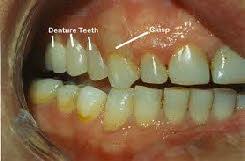Fillings, Crowns, and Bridges
One of the most common types of dentistry that I do in my practice involve fillings, crowns, and bridges. My philosophy about these three modes of treatment revolves around the concept of “nooks and crannies”. When you have a nook or a crannie in or around a tooth, there exists a “space” that can potentially harbor bacteria.

Cavities
Basically, bacteria (on teeth) need three things to live:
1. Sugar
2. Time
3. “A Nook”
The first two things are within the control of the person. For example, if you slowly sip non-diet sodas all day long, you are providing bacteria with lots of sugar and lots of time.
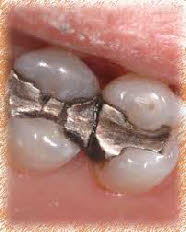
Bacteria are smart. Bacteria eat that same sugar you eat. They use it to live and thrive. Since the bi-product of eating sugar is acidic in nature, this allows bacteria to further erode tooth structure, creating an even BIGGER nook or crannie.

(This process of “nook formation” is what people refer to as “A CAVITY”.)
So, when you drink soda all day long, you are giving bacteria plenty of time to form these cavities.
(I’m not condoning drinking soda, but if you have to have one, then slam it real quick, and brush your teeth afterwards!)
So, once the “Nook” is already present, either as a result of natural anatomy, a crack, a fractured tooth, or actual bacterial “cavity” formation, it then becomes the responsibility of the dentist. People can not control or change the nicks and grooves that may exist in a tooth. It is the dentist’s job to find the nooks, document them, and restore them to smooth, free flowing anatomy.
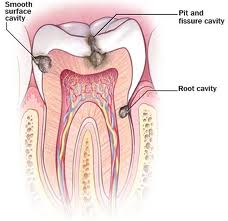
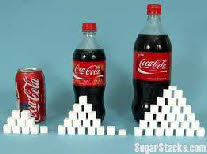
Fillings
The two most common types of “restorations” for small nooks (ie. when there is less than 50% of tooth structure lost) are Amalgam or composite fillings. Amalgams are the “silver” looking fillings (as seen to the right) which, yes, contain mercury. Composites or “Resin Bonding” are tooth colored fillings that can be matched to an almost exact color of the tooth. Ninety five percent of the restorations I do in my practice are composite bonding.
“Bonding” is arguably one of the biggest technological advances to ever happen in dentistry. Bonding is a just fancy way of saying we’ve figured out how to glue something to a tooth. An amalgam passively sits in a tooth and is held in by dovetails and undercuts; whereas, a composite is physically attached to the tooth. Although amalgams are durable and have many positive long term characteristics, composites have opened the door to things like veneers, esthetic anterior fillings, and many other aspects of cosmetic dentistry. Moreover, cosmetic dentistry would not exist if it were not for Bonding.



Crowns
In situations when there is more than 50% of structure lost from a tooth, fillings are prone to breakage, and a “Crown” becomes the treatment of choice.
A crown is like a prosthetic “cap” for the tooth. It can be made out of all gold, all porcelain, or “PFM” (porcelain fused to metal alloy). Crowns are extremely strong and provide the tooth with 360 degrees of support. An all porcelain crown or PFM crown can be made to exactly duplicate the appearance of a natural tooth.
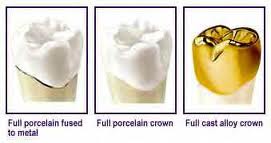
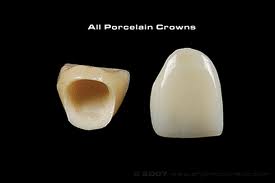
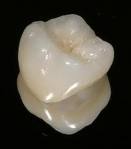
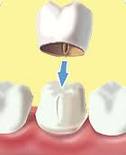
Bridges
A bridge is like 3 or more crowns fused together. They are used when there is one or more missing teeth. The crowns on the ends are like “caps” supported by teeth and the middle crown is a solid prosthetic replacement for the missing tooth. Bridges are “fixed” ie. the patient can not take it out. It is a nice way to replace a missing tooth (or teeth). It is one way to get a patient back to the esthetics and function they had before any teeth were lost.
The main difference between a bridge and untouched natural teeth is that floss can not pass between the teeth contained in a bridge. Bridge teeth are connected in order to support the missing tooth. I give patients special floss threaders and brushes which allow them to clean under the bridge.
But, a bridge can be completed in a matter of weeks, most insurances cover this form of treatment, and it is a quick (and quality) way to restore a patient back to ideal esthetics and chewing function.
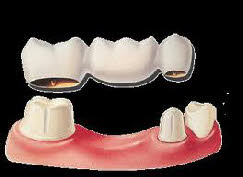
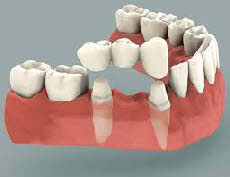


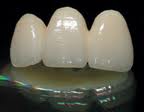
Other Tooth Replacement Techniques
Other ways to replace missing teeth include Implants or Partial Dentures (discussed in their own sections of this web site).
Implant Bridge Partial Denture
In my opinion, long term, implants are the most ideal form of treatment for tooth loss. In contrast to bridges, an implant offers a bone anchored, free standing support for a tooth; whereas, a bridge relies on the support of the adjacent teeth. Implant crowns and bridges have to be replaced less often, the patient can floss on either side of an implant crown, and it is more hygienic.
However, implants are often not covered by insurance and, depending on the specific patient, they potentially can take much more time to complete. In addition, the implant placement procedure is a minor surgery. It is more invasive than a bridge procedure. Therefore, the medical condition of the patient is more critical to the success of the procedure.
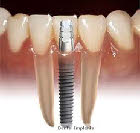



If the “Implant” is the Ferrari of the tooth replacement procedure (solid, highest quality, harder to attain, and more expensive)

And the “Bridge” is the Toyota (a quality product for the money, looks pretty good, gets the job done),

Then the removable partial denture is the Volkswagon (much less expensive, a little uncomfortable, not as esthetic, but gets you from point A to point B).
In terms of a partial denture, the main difference is that they are removable. They can include a metal framework that clips into undercuts and grooves on the remaining teeth and supports prothetic denture teeth in the edentulous area. The big advantage of a “partial” is that you can restore multiple teeth at once for a relatively low cost. The disadvantage is that it is an appliance that you wear in your mouth, it can effect speech in the beginning and there can be some esthetic compromises due to the clasps needed to retain the denture.
I also make “gum colored” partial dentures (ie. “Valplast”). These have flexible gum colored clasps and framework instead of metal. They are more esthetic and a very useful treatment option with anterior tooth loss.
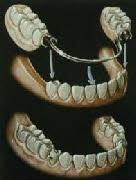

The bottom line is that you pay for what you get. I perform all of the procedures outlined above, so I can give patients an unbiased opinion on pros and cons of each. There are many ways to replace teeth and some patients require a combination of options to cater to specific financial, functional, and esthetic needs. I am very open to all avenues of treatment and readily available to any patient concerns or questions.
